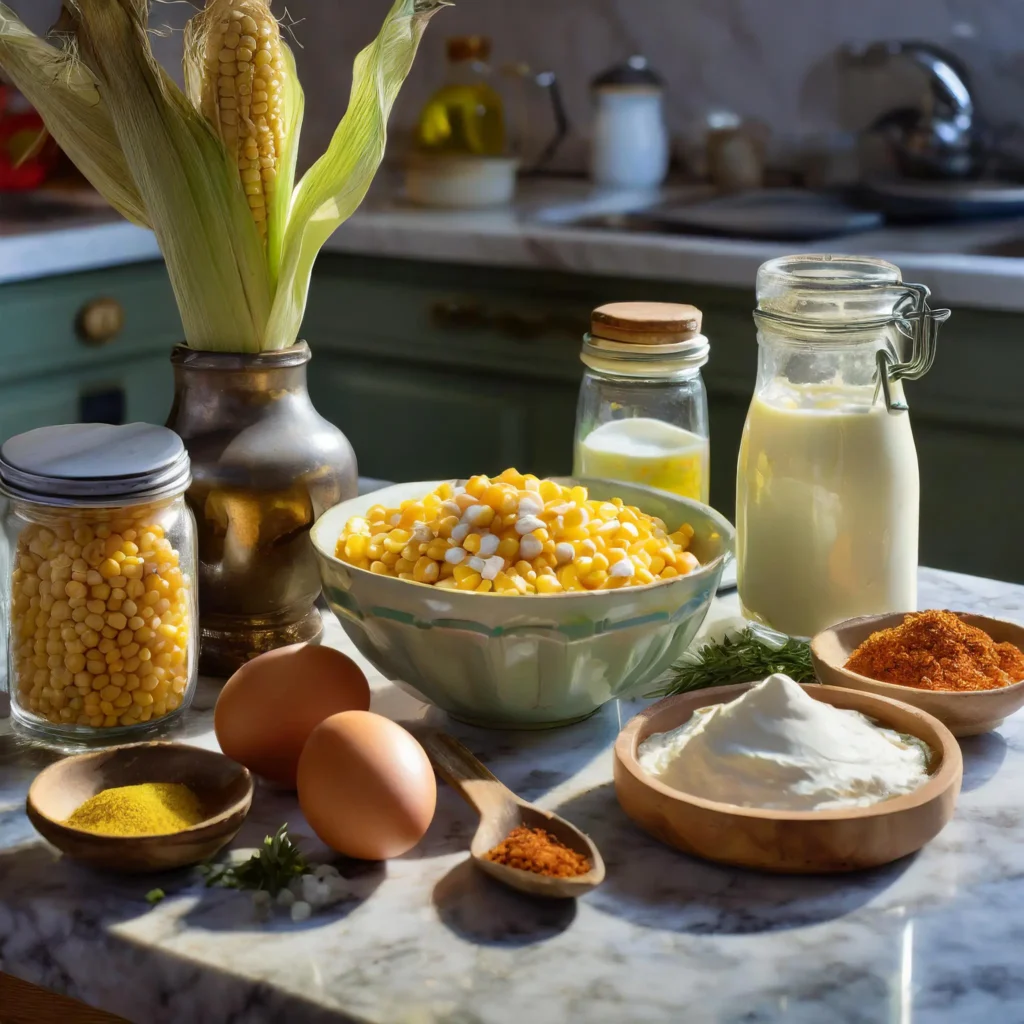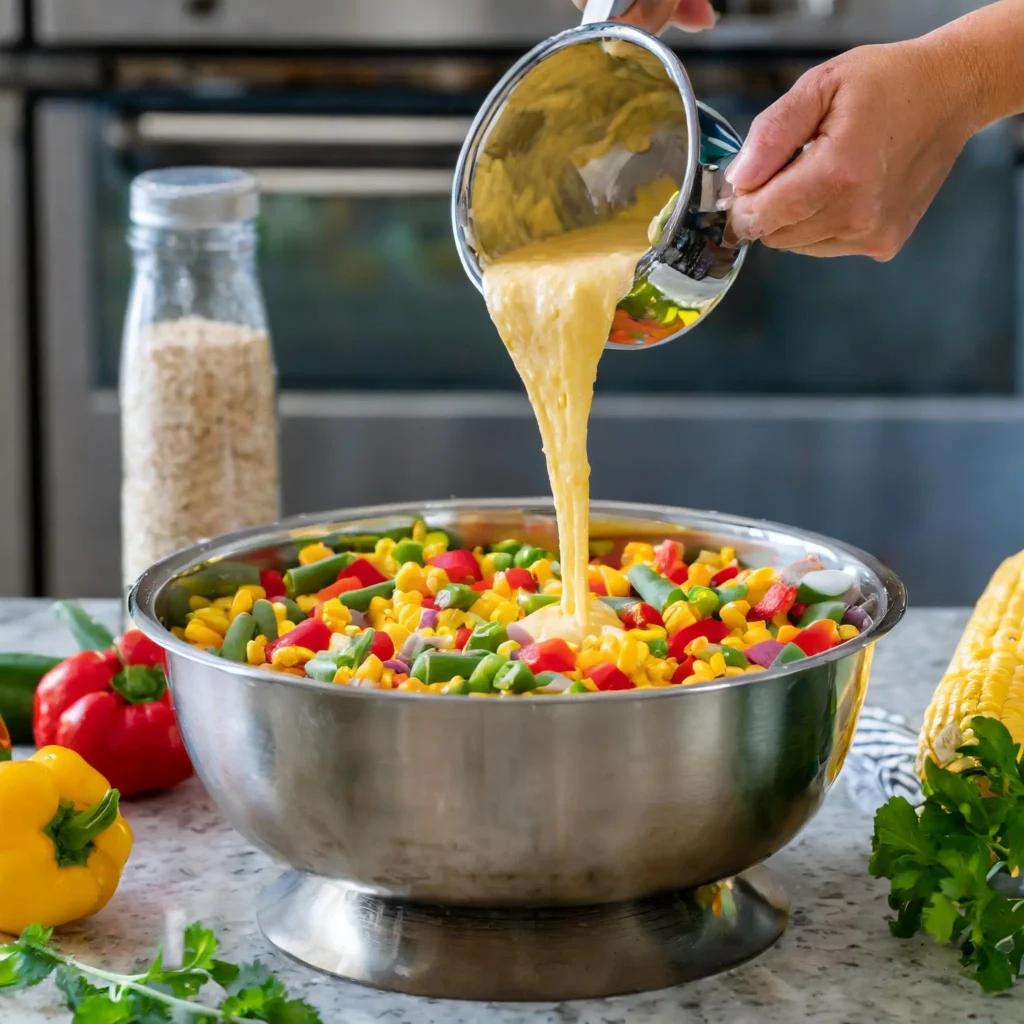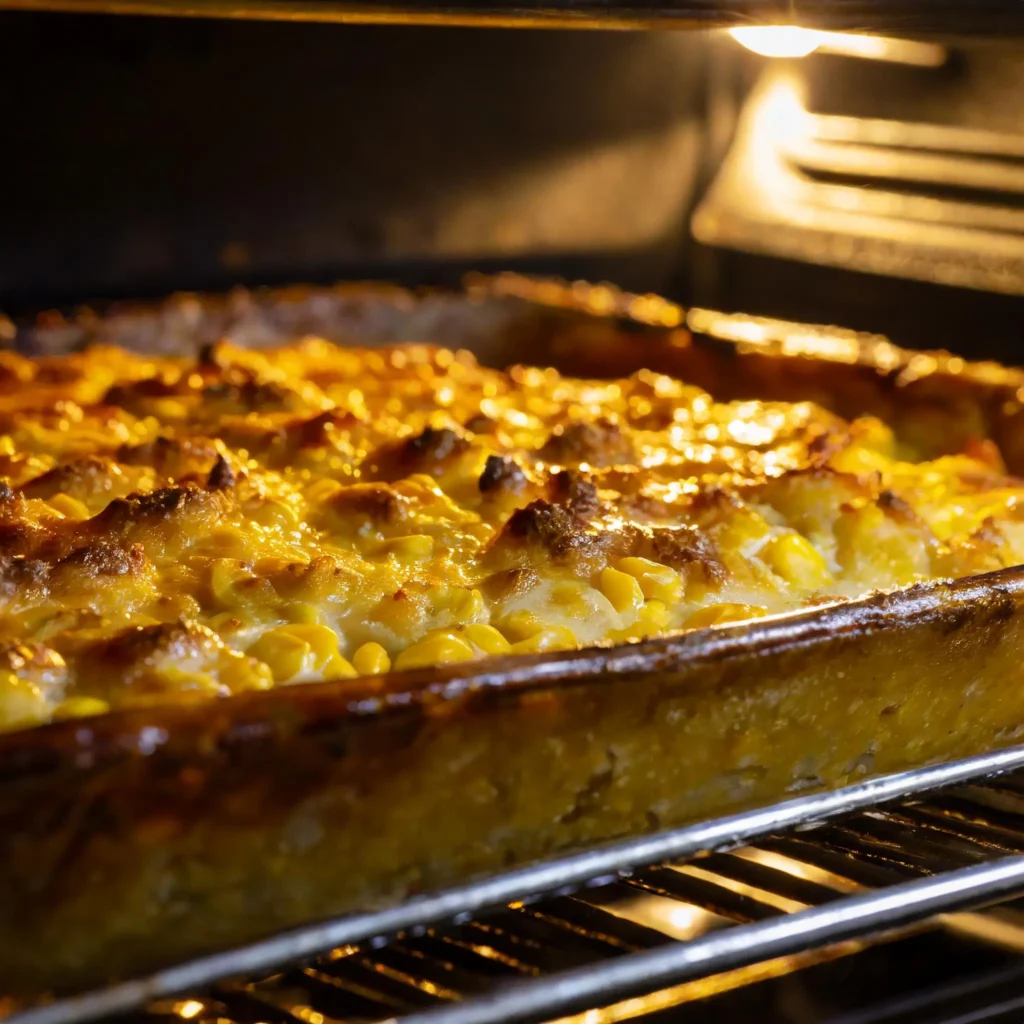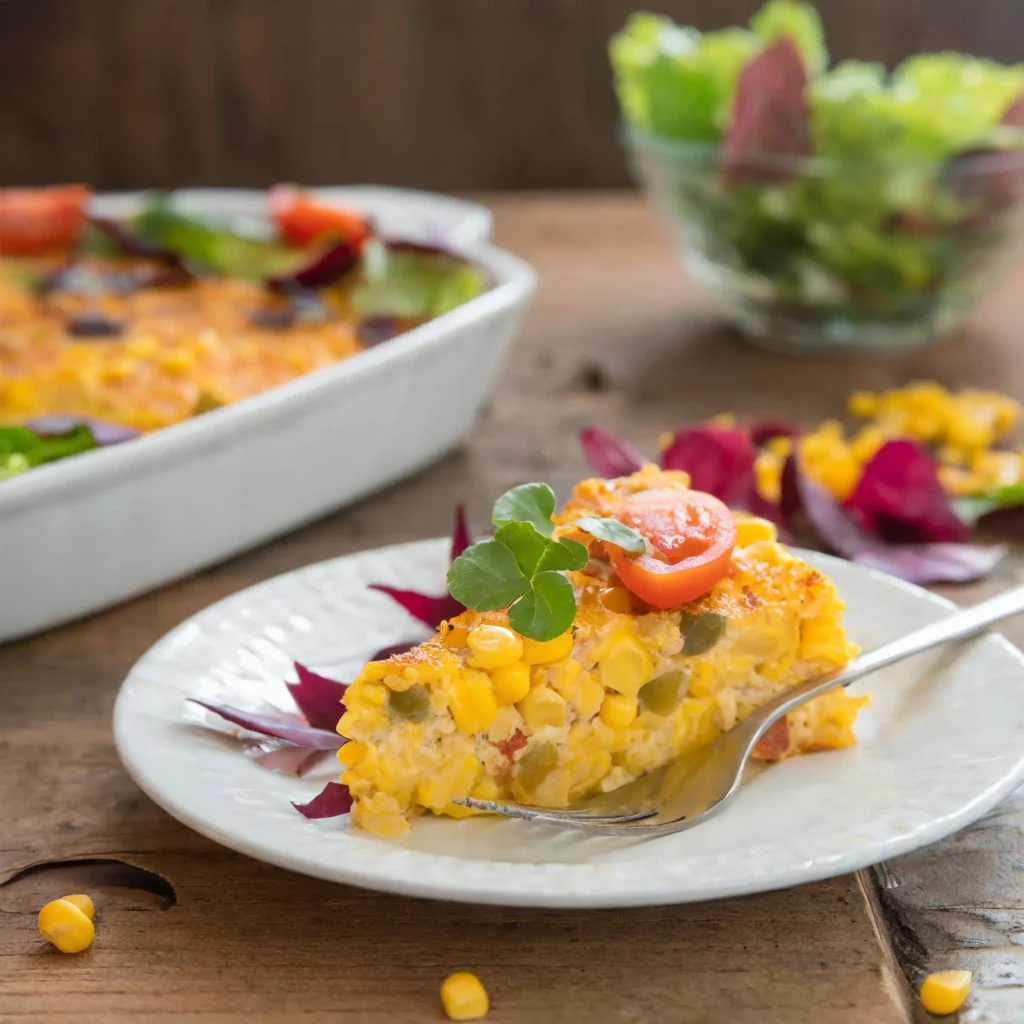Corn casserole is a beloved comfort food known for its creamy texture, sweet-savory flavor, and warm appeal at family gatherings. This dish, often served as a side or main dish during holidays, pairs beautifully with other homestyle favorites. However, traditional recipes frequently rely on calorie-dense ingredients such as heavy cream, butter, and sugar, making it a less-than-ideal choice for health-conscious eaters.
This article introduces a healthier take on corn casserole, focusing on preserving its rich flavor and satisfying texture while improving its nutritional profile. Whether you’re a seasoned cook looking to revamp your recipe or a beginner seeking a wholesome crowd-pleaser, this guide will help you create a dish that satisfies your taste buds and dietary goals alike.
When discussing the versatility of corn in various dishes, link to an article on “Delicious Corn-Based Dishes” using the anchor text “variety of corn-based dishes”.
Table of content
Origins of Corn Casserole
Corn casserole has deep roots in American culinary history, particularly in Southern cooking, where corn has been a staple crop for centuries. Dishes like cornbread, hush puppies, and grits emerged from the necessity of using readily available ingredients, and corn casserole naturally evolved as a fusion of these classic recipes.
The dish became a popular addition to family gatherings and festive meals because of its simplicity and adaptability. Families could adjust the ingredients based on availability, making corn casserole a versatile and beloved comfort food.
For more details on the traditional ingredients that make up this classic dish, check out What Is Corn Casserole Made Of? to explore its core components and historical roots.
Traditional Southern Roots
The history of corn casserole can be traced back to Southern cuisine, where corn has long been a staple crop. Cornbread, hush puppies, and grits are just a few examples of how corn was integrated into everyday meals. Corn casserole emerged as a hybrid of these traditions, combining the heartiness of cornbread with the creamy, custard-like texture of a pudding.
This dish was particularly popular because of its adaptability—families could adjust the recipe to include available ingredients, making it a versatile addition to any table. From church potlucks to Thanksgiving feasts, corn casserole became synonymous with comfort and community.
Modern Variations
Over time, corn casserole recipes have evolved to reflect changing culinary preferences and ingredient availability. While traditional versions often relied on simple pantry staples like cornmeal, creamed corn, and eggs, modern recipes frequently incorporate processed ingredients such as canned creamed corn, cornbread mix, and shredded cheese for convenience.
However, the rise of health-conscious cooking has encouraged many home cooks to revisit the classic recipe. Today, lighter versions of corn casserole use wholesome ingredients like Greek yogurt, almond flour, and fresh corn, preserving its rich taste while boosting its nutritional profile.
To better understand how corn-based dishes vary, explore Corn Pudding vs Casserole: Key Differences, where you can learn how these two beloved recipes compare in texture, flavor, and preparation.
Transforming a Classic Dish
Giving a healthy twist to corn casserole involves more than simply swapping ingredients. It requires a thoughtful balance of flavor, texture, and nutrition. This section dives into how to modify the traditional recipe to create a healthier version without sacrificing the dish’s essence.
Identifying the Common Ingredients in Corn Casserole
Traditional corn casserole recipes typically include ingredients like creamed corn, sour cream, butter, sugar, eggs, and cornbread mix. While these components contribute to the dish’s signature richness, they also add calories, unhealthy fats, and refined sugars. Identifying these components is the first step toward creating a lighter version.
For instance:
- Creamed Corn: Often contains added sugars and thickeners.
- Sour Cream: A high-fat dairy product.
- Butter: Rich in saturated fats.
- Sugar: Adds unnecessary sweetness.
- Cornbread Mix: May contain preservatives and refined flour.
For another creative take on corn-based cooking, check out Homemade Arepas, a delicious corn-based dish made from fresh ingredients that highlights the versatility of corn in global cuisine.
Swapping for Healthier Alternatives
A successful recipe makeover uses healthier substitutes that mimic the traditional flavors and textures. Here’s how to lighten up your corn casserole:
- Creamed Corn: Replace canned creamed corn with fresh or frozen corn blended with a small amount of low-fat milk or unsweetened almond milk. Add a pinch of cornstarch for thickening if needed.
- Sour Cream: Opt for Greek yogurt, which provides the same tanginess but is high in protein and lower in fat.
- Butter: Reduce the amount and replace part of it with olive oil or unsweetened applesauce for a natural, moist texture.
- Sugar: Eliminate added sugar or use a natural sweetener like honey or a sugar substitute such as stevia in moderation.
- Cornbread Mix: Make a homemade mix with whole wheat flour, cornmeal, baking powder, and a touch of salt for a cleaner alternative.
Techniques for Reducing Fat and Calories
In addition to ingredient swaps, certain techniques can reduce the dish’s calorie and fat content while retaining its appeal.
- Use fewer egg yolks and substitute egg whites for binding.
- Incorporate vegetables like diced bell peppers, zucchini, or spinach for added nutrients and bulk.
- Use low-fat cheese sparingly or skip it altogether, relying on herbs and spices for flavor enhancement.
Making these adjustments can transform a calorie-dense comfort food into a healthier dish that suits a variety of dietary preferences. The next section explores the key ingredients you’ll need to craft your updated corn casserole.
Key Ingredients for a Healthy Corn Casserole
Crafting a healthier corn casserole starts with selecting high-quality, nutrient-rich ingredients. By focusing on fresh, whole foods and clever substitutions, you can create a dish that is both wholesome and flavorful. This section outlines the essential components for your revamped recipe.

Selecting the Best Corn
Corn is the star of the casserole, so choosing the right type is crucial. Here’s a breakdown of your options:
- Fresh Corn: The best choice for natural sweetness and texture. If in season, fresh corn kernels cut straight off the cob provide a crisp, juicy bite.
- Frozen Corn: A convenient and nutritious alternative. Frozen corn retains most of its nutrients and doesn’t contain added salt or sugar.
- Canned Corn: While an option, it’s best to opt for no-salt-added varieties and rinse thoroughly to reduce sodium.
For extra depth, consider roasting or grilling the corn before incorporating it into the casserole. This adds a smoky flavor that enhances the dish’s complexity.
Alternative Bindings and Add-ins for Corn Casserole
Binding ingredients like eggs, dairy, and cornbread mix are essential to the casserole’s structure. Healthier alternatives can provide the same function with added nutritional benefits.
- Eggs: Use a combination of whole eggs and egg whites to reduce cholesterol while retaining the dish’s stability.
- Greek Yogurt: A tangy, protein-rich substitute for sour cream. Choose plain, unsweetened varieties for the best results.
- Whole Wheat Flour or Gluten-Free Options: Replace refined flour in homemade cornbread mix with whole wheat flour or almond flour for added fiber and nutrients.
- Additional Add-ins: Incorporate diced vegetables like red bell peppers, green chilies, or zucchini for a pop of color and extra vitamins. For added protein, include cooked chicken, black beans, or tofu.
Enhancing Flavor with Herbs and Spices
Flavor doesn’t have to come from salt or processed ingredients. Fresh herbs and spices can elevate your corn casserole to a gourmet level.
- Herbs: Chopped cilantro, parsley, or chives add a burst of freshness.
- Spices: Paprika, garlic powder, cumin, or a pinch of cayenne can create a warm, savory depth.
- Natural Sweetness: Instead of added sugar, rely on the natural sweetness of corn. A touch of honey or maple syrup can be used sparingly if desired.
By carefully selecting your ingredients and balancing flavors, your corn casserole will not only taste delicious but also nourish the body. In the next section, we’ll cover the step-by-step preparation process to bring this dish to life.
The Step-by-Step Guide to Making Corn Casserole
Now that you’ve gathered the essential ingredients, it’s time to bring your healthier corn casserole to life. This section walks you through each stage of preparation, from ingredient prep to baking perfection.

Prepping the Ingredients
Preparation is key to ensuring a smooth cooking process and a flawless final dish. Here’s how to get started:
- Measure and Prepare Ingredients: Gather all your ingredients in advance. This includes pre-measuring Greek yogurt, whisking eggs, and chopping any optional vegetables or herbs.
- Choose the Right Corn: If using fresh corn, shuck and remove kernels with a sharp knife. For frozen corn, allow it to thaw and drain excess moisture. Rinse canned corn if applicable.
- Prepare the Baking Dish: Lightly grease a baking dish with olive oil or a non-stick cooking spray to prevent sticking and make cleanup easier.
Mixing and Combining
Achieving the right consistency for your casserole is crucial. Follow these steps for optimal results:
- Combine Wet Ingredients: In a large bowl, mix Greek yogurt, eggs (or egg whites), and a small amount of olive oil or unsweetened applesauce. Whisk until smooth.
- Add the Corn and Vegetables: Fold in the corn, diced vegetables, and optional add-ins like black beans or shredded chicken. Stir gently to distribute evenly.
- Incorporate Dry Ingredients: Gradually mix in whole wheat flour or a gluten-free substitute, along with any baking powder or spices. Avoid overmixing, as this can result in a dense texture.
- Layer for Texture: If desired, sprinkle a thin layer of low-fat shredded cheese between layers for added flavor without overwhelming the dish.
Baking Tips for Perfect Corn Casserole
Baking your casserole correctly ensures it’s cooked evenly and has a delightful texture. Here are the steps:
- Set the Oven Temperature: Preheat your oven to 375°F (190°C). This temperature ensures the Corn casserole cooks through without drying out.
- Bake with Care: Pour the mixture into the prepared baking dish, spreading it evenly. Cover with foil to prevent excessive browning on top during the first half of the baking time.
- Timing and Texture: Bake for 30–35 minutes, then remove the foil and bake for an additional 10–15 minutes, or until the top is golden and a toothpick inserted in the center comes out clean.
- Rest Before Serving: Let the casserole rest for 5–10 minutes before slicing. This allows the flavors to meld and ensures clean slices.

Tips for Serving and Presentation
- Garnish with freshly chopped herbs like cilantro or parsley for an appealing look.
- Serve warm as a side dish or as a light main course with a salad.
With these steps, your healthy corn casserole will turn out perfectly every time. Up next, we’ll explore the nutritional benefits of this revamped classic.
Nutritional Benefits of the Healthy Version
Revamping the classic corn casserole into a healthier dish doesn’t just make it more suitable for various diets; it also significantly boosts its nutritional profile. By choosing wholesome ingredients and avoiding processed ones, you can transform this comfort food into a nutrient-rich addition to your meals.
Lowering Calories and Fats
One of the primary benefits of the healthier version is its reduced calorie and fat content. By swapping ingredients like butter and sour cream for lighter alternatives, you can enjoy the dish guilt-free. Here’s how these changes impact the casserole:
- Reduced Saturated Fats: Using olive oil or Greek yogurt in place of butter and full-fat sour cream decreases unhealthy fats while maintaining moisture and flavor.
- Lower Calorie Count: Eliminating sugar and using natural sweeteners, if needed, cuts unnecessary calories without affecting taste.
Boosting Vitamins and Minerals
Corn is naturally rich in vitamins and minerals, and incorporating fresh vegetables and nutrient-dense ingredients enhances the dish further:
- Corn: A good source of fiber, vitamin C, and B vitamins, which support digestion and energy production.
- Vegetables: Additions like bell peppers, zucchini, or spinach increase vitamin A, potassium, and antioxidants.
- Greek Yogurt: Provides calcium and protein, supporting bone health and muscle repair.
- Whole Grains: Using whole wheat flour or cornmeal boosts fiber content, promoting heart health and satiety.
Corn Casserole Suitability for Dietary Preferences
Another advantage of this healthy corn casserole is its adaptability to various dietary needs. Here are a few modifications to suit specific preferences:
- Gluten-Free: Replace wheat flour with almond or oat flour for those avoiding gluten.
- Vegan-Friendly: Substitute eggs with flaxseed meal and Greek yogurt with dairy-free yogurt or blended silken tofu.
- Low-Carb: Reduce the quantity of corn and incorporate additional low-carb vegetables like cauliflower or zucchini.
These variations ensure that the dish remains inclusive without compromising on flavor or texture.

Promoting Healthy Eating Habits
By making small but impactful adjustments to beloved recipes like corn casserole, you can encourage healthy eating habits within your household. Preparing such dishes demonstrates that nutritious food can be satisfying and flavorful, helping to bridge the gap between indulgence and health-conscious eating.
FAQs About Healthy Corn Casserole
Can I Make Corn Casserole Without Eggs?
Yes, you can prepare a delicious egg-free version of corn casserole! Instead of eggs, use flaxseed or chia seed substitutes by mixing 1 tablespoon of ground seeds with 3 tablespoons of water per egg. Let the mixture sit for 5–10 minutes until it forms a gel-like consistency. Silken tofu or unsweetened applesauce can also work well for binding the ingredients.
For more inspiration on egg-free baking, check out Eggless Pancakes, where you’ll find practical tips for making delicious pancakes without eggs. These adjustments can easily translate to creating a flavorful, egg-free corn casserole.
What’s the Difference Between Corn Pudding and Corn Casserole?
Corn pudding is smoother, creamier, and custard-like due to a higher proportion of liquid ingredients like milk or cream. Corn casserole, on the other hand, is thicker and more bread-like, often using cornmeal or cornbread mix for structure.
As you experiment with this healthier corn casserole recipe, you might have questions about ingredients, storage, and variations. Below are answers to some of the most commonly asked questions to guide you.
Can I Make It Vegan?
Yes, you can make a vegan version of this dish! Here’s how:
- Egg Substitute: Use flaxseed meal or chia seeds mixed with water (1 tablespoon seeds + 3 tablespoons water per egg).
- Dairy-Free Yogurt: Replace Greek yogurt with unsweetened coconut or almond-based yogurt for the creamy texture.
- Cheese Substitute: Use nutritional yeast or vegan cheese to replicate the cheesy flavor.
These substitutions ensure a flavorful and moist casserole that aligns with vegan dietary preferences.
How Do I Store and Reheat Leftovers?
Proper storage and reheating can preserve the texture and flavor of your corn casserole:
- Storage: Allow the casserole to cool completely, then store it in an airtight container in the refrigerator for up to 3–4 days.
- Reheating: Reheat in the oven at 350°F (175°C) for about 15 minutes or until warmed through. Cover the dish with foil to prevent it from drying out. For quicker reheating, use a microwave-safe dish and heat in short intervals to avoid overcooking.
What Goes Well with Corn Casserole?
Corn casserole pairs wonderfully with a variety of dishes. Here are a few popular pairings:
- Proteins: Roasted chicken, grilled fish, or plant-based proteins like tempeh.
- Vegetables: Steamed broccoli, sautéed green beans, or a fresh salad.
- Grains: Serve alongside quinoa or brown rice for a balanced meal.
This versatile dish complements both hearty main courses and lighter fare.
Can I Freeze the Dish?
Yes, corn casserole freezes well if prepared and stored properly:
- Freezing Before Baking: Assemble the casserole, cover it tightly with plastic wrap and foil, and freeze for up to 3 months. When ready to bake, thaw in the refrigerator overnight and bake as directed.
- Freezing After Baking: Allow the casserole to cool completely, portion it into freezer-safe containers, and freeze. Reheat directly from frozen in the oven at 375°F (190°C) until heated through.
How Do I Add Protein to the Recipe?
Adding protein to your corn casserole makes it a more filling and balanced meal. Consider these options:
- Meat: Shredded chicken or lean ground turkey works well.
- Plant-Based: Add black beans, chickpeas, or crumbled tofu for a vegetarian protein boost.
- Cheese: Use low-fat cottage cheese or a sprinkle of Parmesan to increase protein content.
These additions ensure a satisfying dish suitable for both vegetarians and meat lovers.
What Are Some Creative Variations?
Get creative by adding unique ingredients to your casserole:
- Spicy Kick: Include diced jalapeños or a pinch of cayenne pepper.
- Southwestern Style: Add black beans, salsa, and a dash of cumin for a Tex-Mex twist.
- Breakfast Casserole: Mix in cooked turkey bacon and top with an egg for a hearty morning dish.
Conclusion
Corn casserole is a versatile and comforting dish that, with a few thoughtful adjustments, can become a nutritious addition to your table. By replacing high-calorie ingredients with healthier alternatives and experimenting with fresh herbs and spices, you can enjoy all the rich flavors of this classic dish without compromising your dietary goals.
Whether you’re preparing it for a holiday gathering, a weeknight dinner, or meal prep, this healthy twist on corn casserole is sure to delight your taste buds and nourish your body. Give it a try—you might just discover a new family favorite!
People Also Ask:
1. What is corn casserole made of?
2. What’s the difference between corn pudding and corn casserole?

